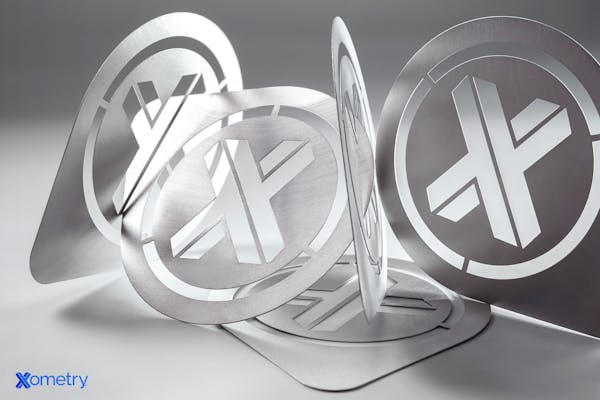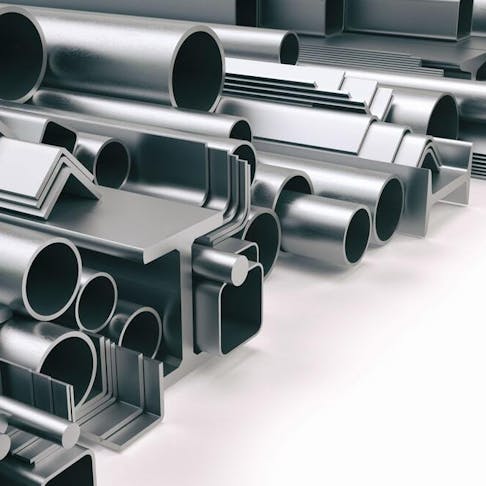6060 aluminum alloy is a heat-treatable aluminum-magnesium-silicon alloy known for its good corrosion resistance, excellent formability, and weldability. With magnesium and silicon as its primary alloying elements, 6060 is particularly well-suited for structural and architectural applications where a high-quality surface finish is important, such as extruded profiles for doors, windows, curtain walls, and interior fittings.
This article provides an overview of the composition, temper grades, typical applications, key characteristics, and material properties of 6060 aluminum, helping you determine its suitability for your manufacturing or design needs.
What is an Aluminum Alloy?
An aluminum alloy is a mixture that consists mostly of aluminum, with other elements added. Elements like copper, magnesium, zinc, or silicon are added to pure aluminum to create different aluminum alloys. Together, these elements can account for 15% (of wrought alloys) and more (for casting alloys). To make aluminum alloys, pure aluminum is melted. While the aluminum is still in its molten state, the alloying elements are added in the desired amounts. The mixture is then cooled in a controlled way to develop the desired microstructure for that alloy. When compared to pure aluminum, aluminum alloys are stronger. Alloys made of aluminum are lightweight and corrosion-resistant.

What is the Composition of 6060 Aluminum?
The typical chemical composition of 6060 aluminum alloy is as follows (by weight percentage):
- Aluminum (Al): 97.9-99.3%
- Magnesium (Mg): 0.35-0.50%
- Silicon (Si): 0.30-0.60%
- Iron (Fe): 0.10-0.30%
- Manganese (Mn): ≤ 0.10%
- Chromium (Cr): ≤ 0.05%
- Copper (Cu): ≤ 0.10%
- Titanium (Ti): ≤ 0.10%
- Zinc (Zn): ≤ 0.15%
- Residuals: ≤ 0.15%
This composition is defined by standards such as EN 573-3 and ASTM B221, although minor variations may occur depending on the manufacturer and specific processing route. The small additions of magnesium and silicon enable the formation of Mg₂Si precipitates, which contribute to the alloy's moderate strength and excellent corrosion resistance after heat treatment. The composition can be slightly adjusted to optimize extrudability, surface finish, or mechanical performance based on the intended application.
What Are the Characteristics of 6060 Aluminum?
The most important characteristics of aluminum alloy 6060 are its moderate strength, excellent cold formability, corrosion resistance, and weldability, especially in temper T4. Aluminum 6060 is a heat-treatable alloy frequently used for complex cross-sections. 6060 aluminum also responds quite well to anodizing.
What Are the Material Properties of 6060 Aluminum?
Table 1 below lists the material properties of 6060 aluminum:
| Properties | 6060-O | 6060-T1 | 6060-T4 | 6060-T5 | 6060-T6 |
|---|---|---|---|---|---|
Properties Density, g/cm3 | 6060-O 2.7 | 6060-T1 2.7 | 6060-T4 2.7 | 6060-T5 2.7 | 6060-T6 2.7 |
Properties Electric conductivity, % IACS | 6060-O N/A | 6060-T1 49.5 | 6060-T4 48 | 6060-T5 54 | 6060-T6 54 |
Properties Thermal conductivity, W/m·K | 6060-O N/A | 6060-T1 195 | 6060-T4 187 | 6060-T5 209 | 6060-T6 209 |
Properties Specific heat capacity, kJ/kg·K | 6060-O 898 | 6060-T1 898 | 6060-T4 898 | 6060-T5 898 | 6060-T6 898 |
Properties Liquidus temperature, °C | 6060-O 655 | 6060-T1 655 | 6060-T4 655 | 6060-T5 655 | 6060-T6 655 |
Properties Solidus temperature, °C | 6060-O 610 | 6060-T1 610 | 6060-T4 610 | 6060-T5 610 | 6060-T6 610 |
Properties Linear thermal expansion coefficient, 10-6/K | 6060-O 23.4 | 6060-T1 23.4 | 6060-T4 23.4 | 6060-T5 23.4 | 6060-T6 23.4 |
Properties Corrosion resistance | 6060-O Excellent | 6060-T1 Excellent | 6060-T4 Excellent | 6060-T5 Excellent | 6060-T6 Excellent |
Properties Formability | 6060-O Good | 6060-T1 Good | 6060-T4 Good | 6060-T5 Good | 6060-T6 Good |
Properties Workability | 6060-O Good | 6060-T1 Good | 6060-T4 Good | 6060-T5 Good | 6060-T6 Good |
Properties Machining | 6060-O Good | 6060-T1 Good | 6060-T4 Good | 6060-T5 Good | 6060-T6 Good |
Properties Heat treatable | 6060-O True | 6060-T1 True | 6060-T4 True | 6060-T5 True | 6060-T6 True |
Where Is 6060 Aluminum Alloy Used?
Aluminum alloy 6060 is commonly used in structural and architectural applications where a high-quality surface finish, moderate strength, and good corrosion resistance are required. It is frequently found in architectural extrusions such as window frames, curtain wall systems, doors, interior fittings, lighting tracks, and furniture.
How Strong Is 6060 Aluminum?
6060 aluminum is considered to be an alloy of moderate strength. Its mechanical properties vary depending on the product form (for example, bars versus tubes) and the temper condition. For example, 6060-T4 has a tensile strength of ≥120 MPa while 6060-T5 has ≥160 MPa.
What Are the Common Trade Names of 6060 Aluminum?
The common trade names of 6060 aluminum are UNS A96060, AA6060, and Al6060. The primary elements added to this 6000-series aluminum alloy are silicon and magnesium. It is designed for use in wrought products. The Aluminum Association (AA) designates this substance as 6060. It will appear as EN AW-6060 (European standards), AlMgSi (EN chemical name), A96060 (UNS number), and A-GS (AFNOR (French) classification).
How to Identify the Grade of Aluminum Alloys
To identify the grade of aluminum, examine its four-digit numerical designation, which indicates the alloying elements and whether it’s a cast or wrought alloy. These grades follow the Aluminum Association (AA) classification system.
Cast Aluminum Alloys
Cast aluminum alloys use a four-digit number with a decimal point (e.g., 3xx.x). The first digit identifies the primary alloying element:
- 1xx.x – 99.xx% pure aluminum
- 2xx.x – Copper, with minor magnesium
- 3xx.x – Silicon, copper, and/or magnesium
- 4xx.x – Silicon
- 5xx.x – Magnesium
- 7xx.x – Zinc
- 8xx.x – Tin
Note: 6xx.x series is not used for cast alloys.
Wrought Aluminum Alloys
Wrought alloys also use a four-digit number, but without a decimal (e.g., 6061). The first digit again indicates the main alloying element:
- 1xxx – 99.xx% pure aluminum
- 2xxx – Copper
- 3xxx – Manganese
- 4xxx – Silicon
- 5xxx – Magnesium
- 6xxx – Magnesium and silicon
- 7xxx – Zinc
By identifying the first digit, you can determine the alloy "series" and gain insight into the material’s composition and properties.
Frequently Asked Questions About 6060 Aluminum Alloy
What Is the Operating Temperature Range for 6060 Aluminum?
6060 aluminum alloys perform well at temperatures below 200 °C. The alloy is sensitive to high temperatures. It loses some of its strength at temperatures above 200-250 °C (392-482 °F). But at subzero temperatures, aluminum alloys don’t get brittle, making them ideal for low-temperature applications.
Is 6060 Aluminum Good for Welding?
Yes, 6060 aluminum is suitable for welding when the right filler wire, such as 4043 (Al-5Si) and 5356 (Al-5Mg), is used.
What Are the Things to Consider When Choosing an Aluminum Grade?
The following factors should be considered when selecting an aluminum grade:
- Weldability: The ability of the alloy to be welded without compromising strength or integrity. Some grades, like 5xxx and 6xxx series, weld well, while others (e.g., 2xxx or 7xxx) may be more difficult to weld.
- Formability (Workability): Can the material be bent or shaped without cracking? 1xxx, 3xxx, and 5xxx series alloys generally offer good formability.
- Corrosion Resistance: How well does the alloy resist environmental degradation? Marine or outdoor applications often use the 5xxx series for its excellent resistance.
- Machinability: How easily can the material be cut or shaped with machinery? The 2xxx and 6xxx series offer good machinability.
- Strength: Is the material strong enough for your application? High-strength grades like 2xxx and 7xxx series are used where structural performance is critical.
- Heat Treating: Heat treatability is the ability of a material to withstand high-temperature treatment and chilling to achieve hardness. Do you need higher hardness or strength through heat treatment? Heat-treatable alloys include the 2xxx, 6xxx, and 7xxx series.
- End-Use Applications: Consider the end-use application's requirements for strength, corrosion resistance, formability, and machinability. What properties should the material have?
Summary
This article presented 6060 aluminum alloys, explained what it is, and discussed its different properties. To learn more about 6060 aluminum alloy and other alloys, contact a Xometry representative.
Xometry provides a wide range of manufacturing capabilities and other value-added services for all of your prototyping and production needs. Visit our website to learn more or to request a free, no-obligation quote.
Disclaimer
The content appearing on this webpage is for informational purposes only. Xometry makes no representation or warranty of any kind, be it expressed or implied, as to the accuracy, completeness, or validity of the information. Any performance parameters, geometric tolerances, specific design features, quality and types of materials, or processes should not be inferred to represent what will be delivered by third-party suppliers or manufacturers through Xometry’s network. Buyers seeking quotes for parts are responsible for defining the specific requirements for those parts. Please refer to our terms and conditions for more information.


